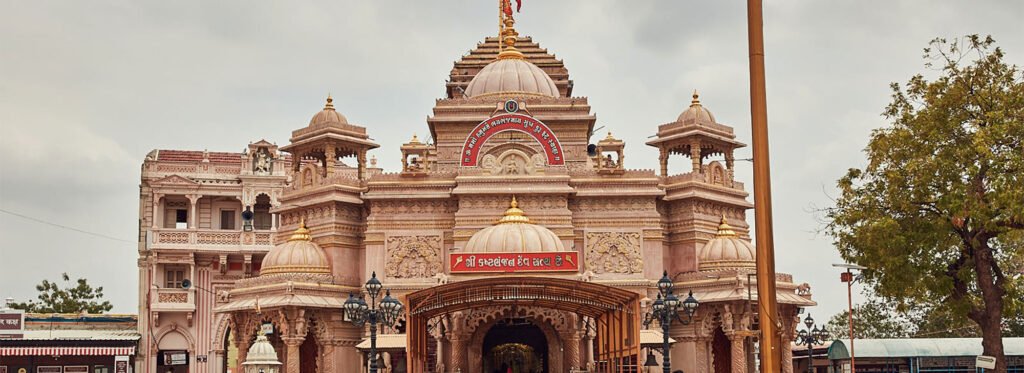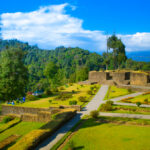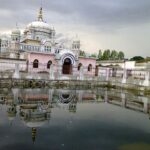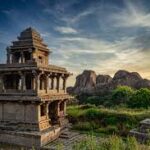Now Reading: Top 5 Best Places to Visit in Botad for Spirituality, History & Nature
-
01
Top 5 Best Places to Visit in Botad for Spirituality, History & Nature

Top 5 Best Places to Visit in Botad for Spirituality, History & Nature
1. Kashtabhanjan Hanuman Mandir

Within Sarangpur of Gujarat state stands Shri Hanuman Mandir which operates under Vadtal Gadi of the Swaminarayan Sampraday. This temple stands unique among Swaminarayan temples because it worships no principal deities of either Swaminarayan or Krishna. Lord Hanuman takes his divine form as Kastbhanjan which represents Sorrows Crusher.
History
Sadguru Gopalanand Swami built the Kastbhanjan Hanuman idol as one of the most respected saints who belong to the Swaminarayan Sampraday. During the idol consecration Gopalanand Swami used a rod to touch it which caused the statue to animate itself. The temple established healing rituals based on this divine occurrence which drew countless distressed and sick people to become pilgrims.
- Several features differentiate the Hanuman idol at Sarangpur from other such representations.
- The image of Hanuman shows a muscular body that carries a wide mustache.
- The divine power dominates evil through his depiction of trampling the female demon underneath his foot.
- The background shows sculpted plants which combine with monkey figures carrying fruits to symbolize the power of devotion and abundant blessings.
Shastri Yagnapurushdas received his appointment from Kothari Gordhandas of Vadtal to manage the temple in 1899. The temple received extensive renovations during his leadership as management director.
- Expansion of the temple complex.
- Construction of an adjacent bungalow.
- The temple purchased new properties which enlarged its land holdings around its grounds.
Worshiping Hanuman at this temple according to devotees will eliminate all negative forces and fears and various health problems. Devotees participate in special healing ceremonies which the temple conducts to receive mental and physical healing from their various conditions. A large number of believers visit the place to seek blessings while having faith in Hanuman’s divine powers.
Best Time to Visit
The temple keeps its doors open to visitors continuously yet devotees strongly prefer the days of Tuesday and Saturday because they are Hanuman’s holy days. The temple welcomes increased numbers of devotees when Hanuman Jayanti occurs along with other Swaminarayan celebrations.
2. Swaminarayan Temple, Gadhada

The Hindu temple named Shri Swaminarayan Mandir operates in Gadhada under its alternate name Gopinathji Mandir. Lord Swaminarayan built this temple himself and it remains one of six temples which he personally established with his guidance during his time.
History
Dada Khachar offered his land to the temple builders as a donation because he was a devoted follower of Swaminarayan. Dada Khachar used the courtyard of his home to construct the temple together with his family who were dedicated followers of Swaminarayan. Swaminarayan oversaw the whole construction process before joining fellow builders to lift both stones and mortar during his hands-on participation in this holy project.
The temple exists as an architectural masterpiece that features two stories along with three domes and intricate stone artwork. The temple rises from a tall foundation structure that gives it commanding visibility from all directions. The complex also includes:
- A spacious assembly hall
- Large dharamshalas (pilgrim rest houses)
- Kitchens for ascetics and devotees
- Idol Installation and Deities
Lord Swaminarayan performed the sacred deities installation in this temple on October 9th of 1828. The idols include:
- Gopinathji and Harikrishna in the middle shrine
- Dharma, Bhakti, and Vasudeva in the western shrine
- Revti-Baldevji, Shri Krishna, and Suryanarayan in the eastern shrine
- People consider the representation of Harikrishna due to its identical physical characteristics and divine resemblance to Lord Swaminarayan directly from God.
The Gadhada Shri Swaminarayan Mandir serves its devotees as an energetic temple that gives them access to spiritual peace together with divine blessings and enlightened teachings. Followers of Swaminarayan Sampraday consider the temple as their essential sacred place of pilgrimage.
Best Time to Visit
Devotees can visit the temple any time because it remains constantly accessible to visitors although major celebrations such as Janmashtami and Diwali and Swaminarayan Jayanti bring thousands of worshippers. People can gain spiritual fulfillment by visiting during major temple celebrations.
related articles : Top 5 Best Places to Visit in Banaskantha for Nature, Temples & Wildlife
Stay Informed With the Latest & Most Important News
Previous Post
Next Post
-
 01Top 5 Best Places Visiting in Gyalshing – Monasteries, Lakes & Scenic Escapes
01Top 5 Best Places Visiting in Gyalshing – Monasteries, Lakes & Scenic Escapes -
 02Top 5 Best Places Visiting in Panna – Temples, Waterfalls & Wildlife Escapes
02Top 5 Best Places Visiting in Panna – Temples, Waterfalls & Wildlife Escapes -
 03Top 5 Best Places to Visit in Malerkotla – Malerkotla Fort, Sheesh Mahal & More
03Top 5 Best Places to Visit in Malerkotla – Malerkotla Fort, Sheesh Mahal & More -
 04Top 10 Best Places Visiting in Dakshina Kannad for Culture, Nature & Coastal Charm
04Top 10 Best Places Visiting in Dakshina Kannad for Culture, Nature & Coastal Charm -
 05Top 2 Best Places Visiting in Chitradurga for History, Nature & Adventure
05Top 2 Best Places Visiting in Chitradurga for History, Nature & Adventure -
 06Best Places Visiting in Shopian – Explore Top Attractions & Hidden Gems
06Best Places Visiting in Shopian – Explore Top Attractions & Hidden Gems -
 07Best Places Visiting in Narmadapuram – Temples, Waterfalls & Wildlife Escapes
07Best Places Visiting in Narmadapuram – Temples, Waterfalls & Wildlife Escapes














Pingback: Top 3 Best Places to Visit in Chhota Udepur – Complete Travel Guide